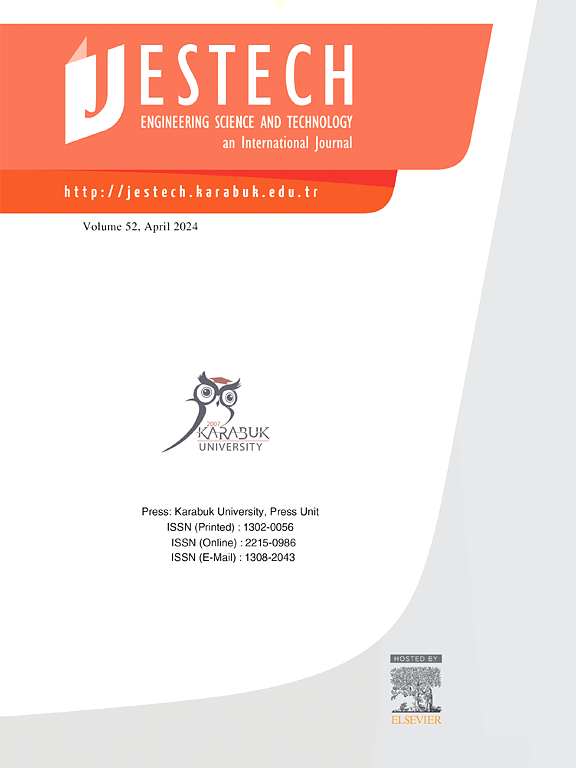Thermohydraulic performance evaluation of a heat exchanger mounted with oval inclined twisted rings
IF 5.1
2区 工程技术
Q1 ENGINEERING, MULTIDISCIPLINARY
Engineering Science and Technology-An International Journal-Jestech
Pub Date : 2025-01-30
DOI:10.1016/j.jestch.2025.101981
引用次数: 0
Abstract
This research examines the effects of oval inclined twisted rings (I-TRs) on thermal performance characteristics. Heat transfer enhancement, friction factor, and thermal enhancement factor tests were conducted under uniform wall heat flux with Reynolds numbers (Re) varying from 6000 to 20,000. A systematic investigation was carried out to examine the influence of different pitch ratios (p/D) and oval-ring inclination angles (θ) on thermal enhancement factor (TEF). The experimental results reveal that the Nusselt number increases with decreasing pitch ratio (p/D) and inclination angle (θ) of the I-TRs. At p/D = 1.5, the Nusselt numbers are approximately 8.59 % to 18.78 % higher than those for I-TRs with p/D values of 2.0 and 2.5. At the smallest inclination angle, θ = 30°, the Nusselt numbers are approximately higher than those at θ = 45°, 60°, 75°, and 90° by around 1.56 %, 7.21 %, 13.74 %, and 27.14 %, respectively. At a p/D ratio of 1.5 and an inclination angle of θ = 30°, the resulting thermal enhancement factor (TEF) consistently exceeds unity across the entire Reynolds number (Re) range. In contrast, for other geometries and configurations, some TEF values fall below unity at higher Re. Within the studied range, the highest TEF of 1.12 is achieved at θ = 30°, p/D = 1.5, and Re = 6,000. The key finding suggests that the performance of the thermal system is highly dependent on both the configuration and operational conditions.

装有椭圆形倾斜扭曲环的热交换器的热水力性能评价
本研究考察了椭圆倾斜扭曲环(I-TRs)对热性能特性的影响。在雷诺数(Re)为6000 ~ 20000的均匀壁面热流条件下进行了传热强化、摩擦因数和热强化因数试验。系统研究了不同间距比(p/D)和椭圆环倾角(θ)对热增强系数(TEF)的影响。实验结果表明,Nusselt数随螺距比(p/D)和倾角(θ)的减小而增大。p/D = 1.5时,Nusselt数比p/D为2.0和2.5时的Nusselt数高8.59% ~ 18.78%。在最小倾角θ = 30°时,Nusselt数比θ = 45°、60°、75°和90°时的Nusselt数分别高出1.56%、7.21%、13.74%和27.14%。在p/D比为1.5、倾角为θ = 30°时,得到的热增强系数(TEF)在整个雷诺数(Re)范围内始终大于1。相比之下,对于其他几何形状和结构,在较高的Re下,一些TEF值低于1。在研究范围内,在θ = 30°,p/D = 1.5, Re = 6000时,TEF达到了1.12的最高值。关键发现表明,热系统的性能高度依赖于配置和操作条件。
本文章由计算机程序翻译,如有差异,请以英文原文为准。
求助全文
约1分钟内获得全文
求助全文
来源期刊

Engineering Science and Technology-An International Journal-Jestech
Materials Science-Electronic, Optical and Magnetic Materials
CiteScore
11.20
自引率
3.50%
发文量
153
审稿时长
22 days
期刊介绍:
Engineering Science and Technology, an International Journal (JESTECH) (formerly Technology), a peer-reviewed quarterly engineering journal, publishes both theoretical and experimental high quality papers of permanent interest, not previously published in journals, in the field of engineering and applied science which aims to promote the theory and practice of technology and engineering. In addition to peer-reviewed original research papers, the Editorial Board welcomes original research reports, state-of-the-art reviews and communications in the broadly defined field of engineering science and technology.
The scope of JESTECH includes a wide spectrum of subjects including:
-Electrical/Electronics and Computer Engineering (Biomedical Engineering and Instrumentation; Coding, Cryptography, and Information Protection; Communications, Networks, Mobile Computing and Distributed Systems; Compilers and Operating Systems; Computer Architecture, Parallel Processing, and Dependability; Computer Vision and Robotics; Control Theory; Electromagnetic Waves, Microwave Techniques and Antennas; Embedded Systems; Integrated Circuits, VLSI Design, Testing, and CAD; Microelectromechanical Systems; Microelectronics, and Electronic Devices and Circuits; Power, Energy and Energy Conversion Systems; Signal, Image, and Speech Processing)
-Mechanical and Civil Engineering (Automotive Technologies; Biomechanics; Construction Materials; Design and Manufacturing; Dynamics and Control; Energy Generation, Utilization, Conversion, and Storage; Fluid Mechanics and Hydraulics; Heat and Mass Transfer; Micro-Nano Sciences; Renewable and Sustainable Energy Technologies; Robotics and Mechatronics; Solid Mechanics and Structure; Thermal Sciences)
-Metallurgical and Materials Engineering (Advanced Materials Science; Biomaterials; Ceramic and Inorgnanic Materials; Electronic-Magnetic Materials; Energy and Environment; Materials Characterizastion; Metallurgy; Polymers and Nanocomposites)
 求助内容:
求助内容: 应助结果提醒方式:
应助结果提醒方式:


